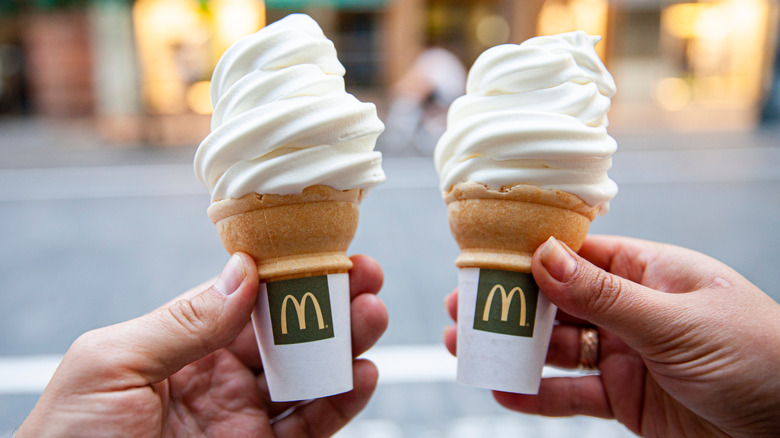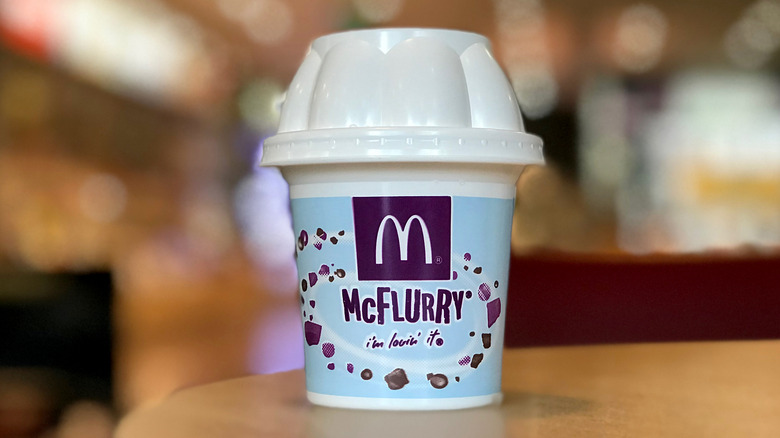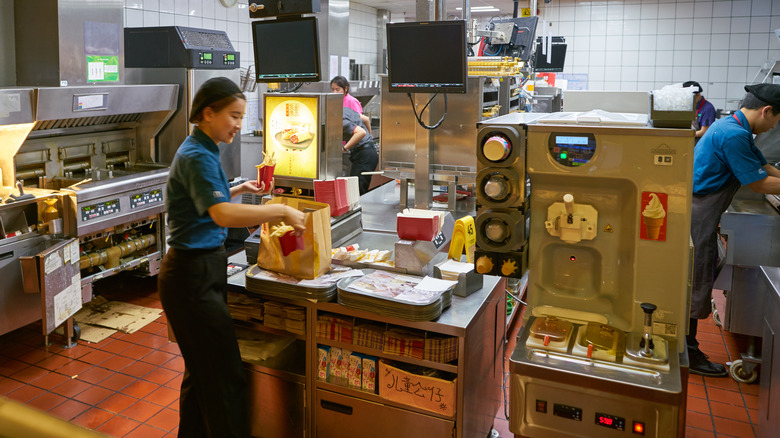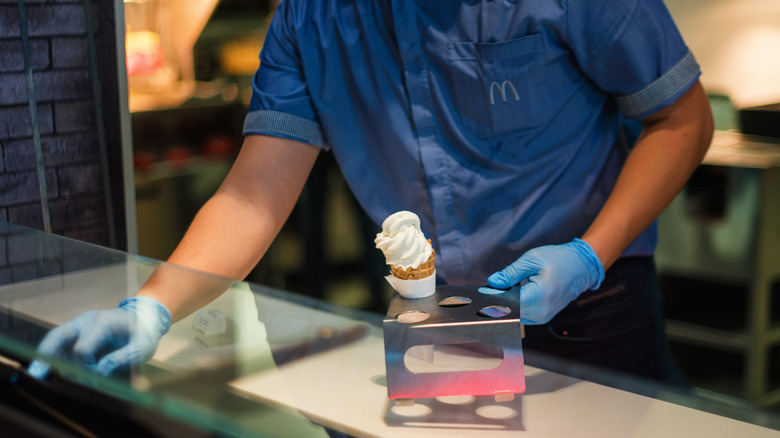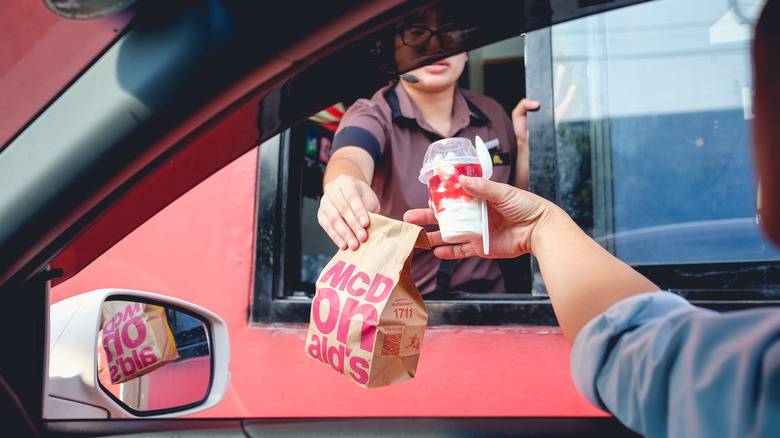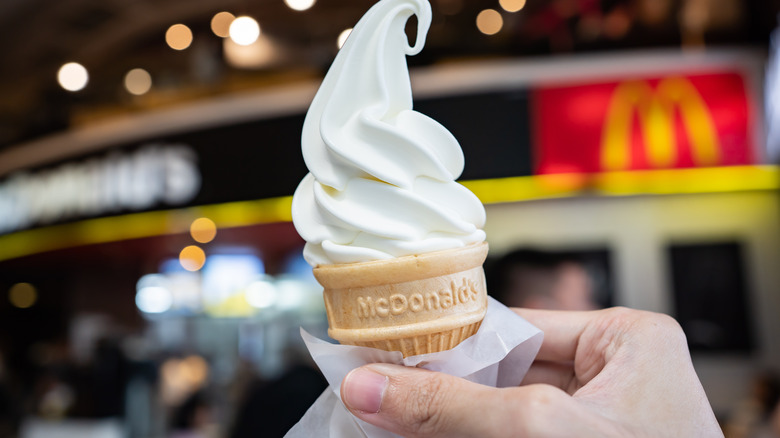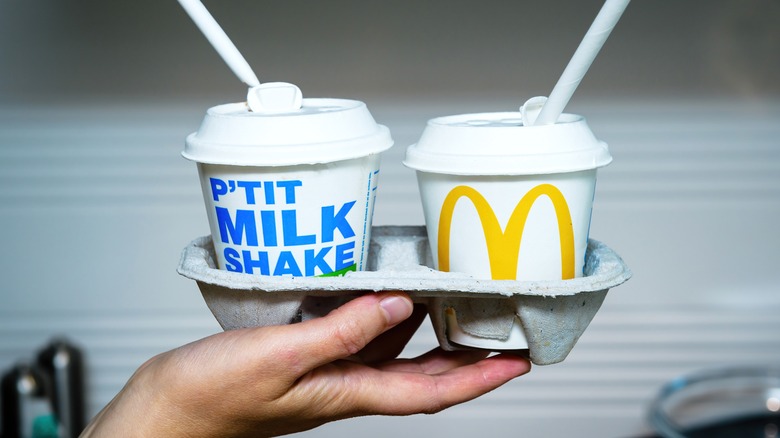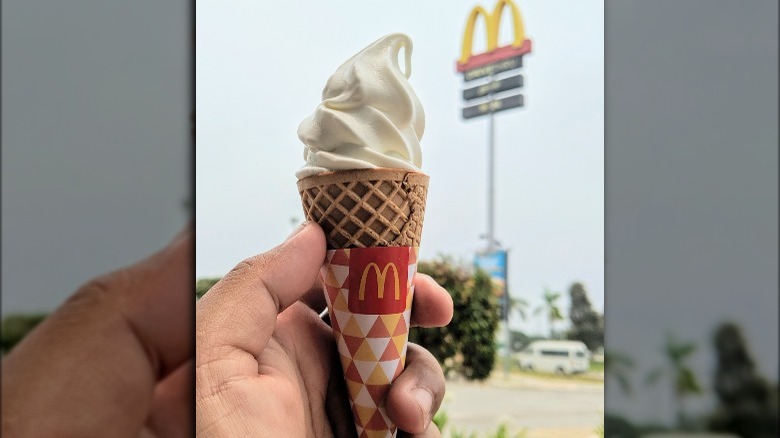The Real Reason McDonald's Ice Cream Machines Always Seem To Be Broken
Ever roll up to the McDonald's drive-thru with an ice cream craving only to find out that the ice cream machine is busted? You're not alone. It's basically a fast food rite of passage. In 2016, broken ice cream machines were the most common service-related complaint to McDonald's on Twitter (via The Wall Street Journal).
Over the years, the fast food restaurant's habitually broken ice cream machines have become a full-fledged meme, but not just any meme: It's a meme so viral that it's withstood literal years, outliving the Trump presidency and finding its way onto TikTok, according to Know Your Meme. In 2020, McDonald's even started roasting itself on Twitter.
For the casual diner, the machines are the sort of minor inconvenience worth a couple Twitter complaints or a short-lived flurry of Change.org petitions — but it's spiraled into something so much more, including lawsuits and, per The Wall Street Journal, a possible FTC investigation. So, what's the deal? If anything is clear, McDonald's fans are not loving it.
McDonald's soft serve is a big business
Though McDonald's quietly changed its soft serve recipe in 2016, the history of McDonald's ice cream spans the better part of a century. Ice cream has been on the menu since at least the late 1940s, but the brand didn't introduce its classic McSundae until 1978. Decades later, the McFlurry made its debut. According to AdWeek, the treat was invented in Canada in 1995, but it's since become an international icon found in 99 different countries.
McDonald's uses soft serve in more than 60% of their desserts, according to CNBC. In some places, you can still get a vanilla cone for $1 — one of the few things a dollar can actually buy in 2022. When Shamrock Shake season rolls around, the company sees a major boom in ice cream sales. Per Wired, the minty St. Patrick's Day-themed milkshake can "boost shake sales as much as tenfold." In other words: a broken ice cream machine can lead to hundreds of dollars of lost revenue.
Overall, The Wall Street Journal estimates that ice cream accounts for 3% of McDonald's sales in the United States. That doesn't seem like a ton, but it actually equates to around $7,650,000 a year. So why is McDonald's seemingly so lax about broken machines?
McDonald's ice cream machines differ from other ice cream machines
To understand why McDonald's ice cream machines are consistently broken, you need to understand how ice cream machines actually work. The key components are a hopper, a barrel, and a scraper blade. According to Wired, liquid ice cream ingredients go through the hopper into the barrel, where they freeze. As the barrel spins, a scraper blade pulls thin sheets of the frozen ingredients off the sides of the barrel and mixes them repeatedly to reduce ice crystals. It then pushes the ice cream through a nozzle, where it lands in your cone.
A McDonald's ice cream machine is a little different. It's more advanced than the kind you'd use at home (unless, of course, you're Jeff Bezos). Most franchises use digital Taylor ice cream machines that have two hoppers and two barrels along with a pump to speed up the dispensing process.
This is how the machines can make both soft serve and milkshakes at the same time. It also helps McDonald's sell up to 10 ice cream cones every minute according to McD Truth, an anonymous franchisee who spoke to Wired. In his words, the machines are the veritable "Italian sports car" of the McDonald's kitchen — but sports cars aren't necessarily easy to fix when they break down.
The machines are notoriously difficult to clean
The problem with McDonald's ice cream machines becomes clear during the cleaning process. It actually needs to be cleaned less than the average ice cream machine. Most commercial ice cream machines need to be disassembled and sanitized every single day. McDonald's ice cream machine needs extensive cleaning just once every two weeks — but this is a difficult process.
A Taylor representative told The Wall Street Journal that "the machines are built up with a lot of interconnecting parts that have to operate in a complex environment and manner." Overall, it's an 11-step process that requires removing seven different parts, including — as Wired reports — no less than over 20 variously-sized O-rings that are all crucial to the machine's function. Forget a ring? It'll disrupt the whole system, and you might spring a leak or jam up a pump.
It's not just inexperienced techs who struggle with the cleaning process, either. Even those who routinely clean the machines have issues with resembling them. One McDonald's tech manager told Wired that he's done the process more than a hundred times, but he's only ever had the machines "work on the first try, at most,10 of those times."
The nightly pasteurization process is a nightmare
The reason McDonald's ice cream machines only need to be cleaned once every two weeks is because they use a nightly pasteurization process. This heats the leftover ingredients to 151 degrees Fahrenheit for 30 minutes before refreezing them. Wired called the process a "modern marvel of hygiene and cost savings," and they're right. It helps McDonald's reuse ingredients they'd otherwise have to throw away — but it's also probably the same reason your local machine is out of service.
As Wired reports, the automated pasteurization process is four hours long. That means that even if the machine isn't broken and the process finishes without a hitch, there's still four hours a day your 24-hour McDonald's can't serve ice cream. Why does it seem like longer? Because it often is.
Pasteurization is finicky, and there's a bevy of potential errors. Something as small as slightly too much (or, for that matter, slightly too little) ice cream mix in the machine can shut down the whole process. Once the digital ice cream machine shows an error message, you have to repeat the entire pasteurization process, which takes another four hours. In other words: if you catch an error at the tail end of pasteurization, you're looking at nearly eight hours out of service (or the equivalent of a full business day).
There's no easy way to repair a McDonald's ice cream machine
There are a lot of reasons McDonald's ice cream machines break down. We're not just talking about a hitch in the automated pasteurization process. We're talking about flat-out broken. When that happens, it's a worst case scenario because there's no easy fix.
According to Vice, McDonald's ice cream machines are infamously tricky to make repairs on. They can only be fixed by a technician who's certified by Taylor, the machines' manufacturer, so it can take weeks depending on their availability. In this case, you're kind of at Taylor's mercy. You can choose another option if you don't want to deal with Taylor, but the decision is like choosing between a turtle and a snail.
According to Wired, franchises don't have to use a Taylor digital ice cream machine, though nearly all of them do. McDonald's does allow the use of a machine sold by Carpigiani, which is less finicky overall. The problem is that Carpigiani is based in Bologna, Italy — and so are the replacement parts. When a machine breaks down, it can take a week for the part to ship across the ocean (meaning a week of no McFlurries).
Is there a solution on the horizon?
The problems with McDonald's ice cream machines don't seem to be stopping anytime soon, but franchise owners may be able to use a work-around. Enter: Kytch. Kytch is a diagnostic device created by Jeremy O'Sullivan and his partner Melissa Nelson as a so-called hack to the fast food giant's over-complicated Taylor machines.
According to Wired, Kytch connects to WiFi. Once it's installed in an ice cream machine, it monitors the machine's functions, logging important data that's often otherwise hidden. From there, it sends the data to a user-friendly, app-based interface where McDonald's employees can troubleshoot issues and make minor repairs. Essentially, it eliminates the need to call a Taylor repair technician for a minor fix — and McDonald's isn't happy.
McDonald's has reportedly discouraged the use of Kytch, claiming it breaches the machine's "confidential information" and can cause "serious human injury." Per Wired, Taylor allegedly sent an email to franchisees, warning that installing a Kytch would void the machine's warranty. In response, Kytch filed a lawsuit that's still playing out in court (via Eat This, Not That).
Broken McDonald's ice cream machines continue to fuel conspiracy theories
McDonald's broken ice cream machines have been subject to numerous conspiracy theories. It goes beyond finicky machines that are difficult to fix. According to the Wall Street Journal, Kytch's lawsuit accused Taylor of running a "multimillion-dollar repair racket."
As Wired reports, Taylor charges franchise owners $18,000 for the machines — but doesn't tell the franchisees much about how the machines work. Instead of divulging this information, Taylor charges hefty fees for maintenance contracts and mandates that only its own technicians can repair the machines. When the technicians do come to make a repair, they allegedly type in a "secret passcode" that opens up a service menu (a service menu that would, presumably, help franchise owners make their own repairs). Wired even published the alleged passcode.
Beyond that, machines only break so much. Some McDonald's fans refuse to believe they're even broken at all — and they might be right at least some of the time. In actuality, broken ice cream machines aren't even one of the top 10 most common repairs in McDonald's kitchens. According to Courtney Bunting, a McDonald's worker who spoke to the Wall Street Journal, some employees just don't want to clean up the mess. "If someone came in 30 minutes before closing and ordered a McFlurry, would you want to risk something else splattering all over the area you just wiped? No," she said.
They even triggered an FTC investigation
A survey of 2,000 McDonald's franchises found that 25% of ice cream machines aren't functional at any given time (via The Wall Street Journal). That's a one in four chance that you won't be able to get your McFlurry — and the Federal Trade Commision (FTC) has taken notice.
According to the Wall Street Journal, the Biden administration launched a widespread effort to find out "whether manufacturers impede owners from fixing their products themselves" — and it included everything from phones and tractors to McDonald's finicky machines. The FTC reportedly started contacting franchises in the summer of 2021 looking for information about the broken ice cream machines, specifically how often they were permitted to try to repair machines on their own.
As of September 2021, the investigation was in a "preliminary" phase. In other words, the FTC was only aware of a potential problem (like most people who saw the memes on TikTok) and hadn't necessarily found evidence of wrongdoing. At the time, McDonald's told the Wall Street Journal that they "had no reason to believe" they were "a focus of an FTC investigation." Months later, it's unclear what exactly the FTC found.
Is your local McDonald's ice cream machine broken? You can check in real time
Waiting in the drive-thru line only to be met with a broken ice cream machine is a unique kind of devastation. When you have a craving for a McFlurry, it's best to never leave it up to chance. You can actually track broken McDonald's ice cream machines in real time with a service called McBroken.
McBroken is the veritable Google Maps of broken McDonald's ice cream machines. According to The Verge, the website, which launched in 2020, was created by 20-something software engineer Rashiq Zahid. After trekking to a McDonalds's in Berlin and discovering he couldn't order a McSundae, he knew he had to step in. Zahid ultimately created a bot that works by using McDonald's app to add McSundaes from every McDonald's location into its cart every 30 minutes. If the sundae isn't available, it's a safe bet that the ice cream machine is broken, and a red dot gets put on the McBroken map.
Some heroes wear capes. Others wear the fresh disappointment of an unsatiated soft serve craving.
